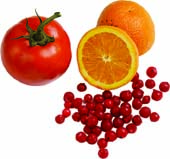Design your own diet
When you know what healthy eating habits are, you can design a personalized diet to help lose weight, according to your particular needs. You only need to follow two basic rules: follow the food pyramid guidelines and cut down on serving sizes.

+ When planning a healthy diet to lose weight you should make sure that you choose foods from at least the five basic food groups. The groups for basic nutritional needs are:
• Starches and grains. Cereals and derivatives. Try to incorporate wholegrains (bread, pastas and flour). Other starches include root vegetables, starchy vegetables and beans.
• Fruits and vegetables. All types, of every color.
• Proteins. Animal products such as lean meats (red, poultry, fish and shellfish) and eggs. Tofu and soy is a vegetarian option.
• Dairy products. Milk, yogurt, cheeses, always choosing skim or hard cheeses.
• Oils. Vegetable oils, beans, avocados and seeds are the healthiest. Other less-healthy fats include butter, mayonnaise, cream and others.
STEP BY STEP DIET
To design a proper diet you shouldn't just keep in mind how many servings you should eat for proper nutrition, but also what does “a serving” mean. This will help you avoid making the mistake of overeating.
FIRST STEP
Knowing what and how much to eat
∎ Grains. Recommended amount of grains is 5 equivalent servings to keep your weight under control. To lose weight, no more than 3 to 4 daily servings.
∎ Fruits and vegetables. To keep your weight under control eat a minimum of 5 servings daily. If you are trying to lose weight eat 4 servings of vegetables and 3 fruit servings daily.
∎ Meat and eggs. To stay healthy and to keep your weight under control 1 to 1½ servings daily (making sure that you choose lean meat) is enough. To lose weight you need the same amount: 1 to 1½ servings, but taking extreme care to eat only lean meats.
∎ Dairy products. To stay healthy and keep your weight under control you need 3 servings daily (1 should be cheese), preferably natural hard cheese. To lose weight you need the same amount, but you should eat skim milk or yogurt and include one hard, natural cheese in this food group.
∎ Oils. To stay healthy and keep your weight under control 2 to 4 servings are recommended, while prioritizing “good” fats (vegetable unsaturated). To lose weight you should include only 2 servings of “good” fats in your daily diet, use oils sparingly.
WARNING
While people with normal weight can eat sugar and consume alcohol in moderation, if you need to lose weight you should eliminate them from your diet altogether.

SECOND STEP
Knowing what counts as a serving
Before designing your daily diet, you should have on hand a list of the quantities for each group, that's to say how much is a serving for each food group and equivalent values. This information will help you design an appropriate diet according to your personal tastes, alternating a diverse range of foods for variety to help you stick with your healthy diet.
∎ Starches and grains. A serving is equivalent to any of the following items:

- • 1 small potato or sweet potato;
- • 2-3 fine slices of potato, sweet potato or corn;
- • 1 cup of cooked pasta;
- • 1 cup of cooked grains (rice, millet, barley, wheat, oatmeal and other whole grains);
- • 1 cup of cooked beans (white beans, lentils, chick peas, pinto beans and others;
- • 1 small bun or pita bread;
- • 2 slices of bread (best if it's wholewheat);
- • 4 thin slices of French bread, toasted;
- • 2 vanilla fingers or 2 Bay Biscuits;
- • 20 oat cakes;
- • ½ cup of breakfast cereal without sugar, preferably whole grain with fiber.
∎ Vegetables. A serving is equivalent to any of the following items:

- • 1 medium vegetable;
- • 1 plate of various raw vegetables;
- • 1 plate of cooked vegetables, not compressed;
- • 2 slices of pumpkin;
- • 1 cup of cooked vegetables, compressed.
∎ Fruit. A serving is equivalent to any of the following items:
- • 1 small fruit (any fruit except banana);
- • 1 cup of sliced fruit/strawberries/melon;
- • ½ large fruit;
- • 2 halves of canned fruit, sugar free;
- • ½ small banana.

∎ Meat-eggs and other proteins. A serving is equivalent to any of the following items:
- • 1 small lean beefsteak (4 in/10 cm in diameter);
- • 2 thin slices of lean beef, roasted;
- • 1 breaded thin steak; baked not fried;
- • 1/4 small chicken, skinless, not fried;
- • 1 small boneless chicken breast (or ½ medium), not fried.
- • 1 small can of tuna in spring water, drained;
- • 1 medium fish fillet;
- • 1 fish steak;
- • 1 egg or 2 egg whites;
- • 3-4 thin slices of cured ham, very dry;
- • 1 cup of tofu;
- • 1 soy patty or soyburger.

∎ Milk. A serving is equivalent to any of the following items:
- • 1 glass of skim milk or yogurt (6½ fl oz/ 200 cc);
- • 3 tablespoons light cream cheese or skim ricotta cheese;
- • 1 slice of natural, hard cheese (2 oz/60 g);
- • 1 small slice of mozzarella cheese or semi hard cheese (1 oz/30 g);
- • 2 thin slices of American cheese on a sandwich;
- • 2 tablespoons of grated Parmesan cheese.
IMPORTANT
Always keep in mind that a serving is equivalent to the following: 1 cup = 6½ oz/200 cc; 1 tablespoon = ½ oz/20 cc.

∎ Oils. A serving is equivalent to any of the following items:

Healthy fats
- • 1 tablespoon of oil (best if it's olive or corn oil);
- • 1 tablespoon of mayonnaise;
- • 2 tablespoons of light mayonnaise;
- • 4 tablespoons of avocado purée;
- • 3 tablespoons of seeds or dry nuts.
Less healthy fats
- • 1 tablespoon of butter or margarine;
- • 2 tablespoons of light margarine;
- • 3 tablespoons of light cream.

THIRD STEP
Designing your daily menu
Once you know the servings for each food type, you can design your own diet plan according to your own tastes and preferences. Just choose a serving of each food for each meal
∎ Breakfast
- • 1 serving of fruit.
- • 1 serving of grains.
- • 1½ servings of dairy products.
- • Water.
- • 1 infusion without sugar.

∎ Lunch
- • 1 serving of raw vegetables.
- • 1 serving of meat.
- • 1 serving of cooked vegetables.
- • 1 serving of oils.
- • 1 serving of fruit.

∎ Snack
- • 1½ servings of dairy products.
- • 1 serving of grains/starch.
- • Water or calorie free drinks.
- • 1 infusion without sugar.


∎ Dinner
- • 1 serving of raw vegetables.
- • 2 servings of grains.
- • 1 serving of cooked vegetables.
- • 1 serving of oils.
- • 1 serving of fruit.



HEALTHY COOKING
To make sure that you're cooking healthily follow these easy steps:
- • Brown vegetables in a nonstick pan, with a vegetable spray.
- • Grill lean beef on a grill or broiler.
- • Add lemon juice, water and a few drops of oil mixed together.
- • Always steam, sauté or bake vegetables.
- • Use sugar-free sweeteners. If you are baking, remember to use artificial sweeteners that tolerate heat.


Comment about this article, ask questions, or add new information about this topic: